In the first part of his South American journey, Mark Bibby Jackson travels through Patagonia Argentina to discover what it is about this remote region that continues to draw the more adventurous traveller.
It must be something in my Welsh genes. Rugby has given me a dummy pass, and my singing skills are best left in the bath tub, but I have always had a hankering to travel in Patagonia; that remote part of South America where my bible-reading, sheep-raising – two further activities I have successfully avoided – ancestors migrated to in the latter half of the nineteenth century; to discover why they travelled the oceans to come here. This is the only explanation for finding myself sat in an Irish bar – there are never any Welsh ones – at the end of the world listening to the Rolling Stones’ Paint it Black while The Simpsons, dubbed into Spanish, is screened unheeded by all customers, in the background.
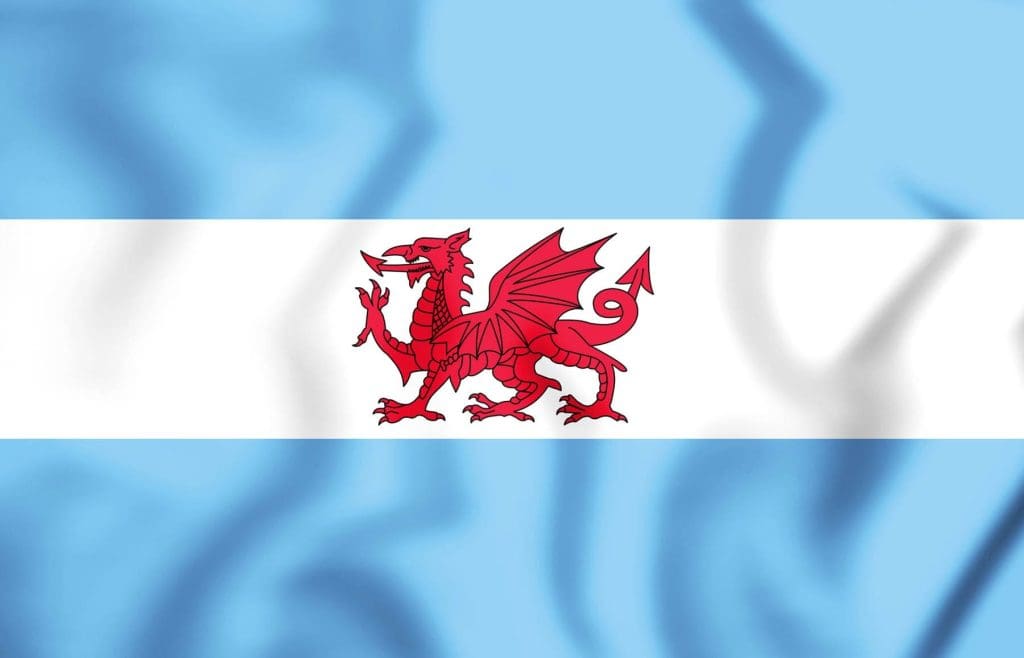
Depending upon your perspective, Ushuaia is either propped at the end of the world or at its beginning. Resting at the tip of the Americas on the island of Tierra del Fuego, Argentina claims it to be the world’s most southerly city – although the nearby Chilean town of Puerto Williams might dispute this claim. For centuries it has served as a refuge from the brutal winds that have ravaged this remote promontory and cost so many sailors their lives. It can have three seasons within an hour as sun turns to snow with an alacrity that puts tropical storms to shame. However there are really only two seasons – winter and more winter, as one local explained to me – with the temperature hovering around freezing point even in the summer month of December.
But I am getting ahead of myself, for this is not the beginning of my story. That started in the heat of Buenos Aires, almost 6,000 kilometres to the north.
Buenos Aires Tango
The Argentinean capital has always been my favourite city in South America, although it has much more of an European feel to it, as though it rightfully belongs in the Iberian Peninsula. In 1998 I came here on my first Latin American adventure that would take me from Rio to Mexico City. Then the city of the carnival had proved a bit of a let down. Perhaps it was my fear of the unknown, but I never felt truly safe in the city where a woman had refused to sell me a bottle of water to take to the beach, saying it was unsafe for foreigners – the beach not the water.
Buenos Aires had proved a breath of fresh air. We were lucky enough to time our arrival for tango week. The streets of the port district surrounding Boca were full of men and women, young and old dancing to the sound of Piazolla. An old man approached an elderly woman and they danced around the square as if they had been in love all their lives, only to depart their separate ways once the music had faded. I even tried to learn the dance of love when I returned to London only to discover that a single left foot coupled with a right were prerequisites for mastering the art.
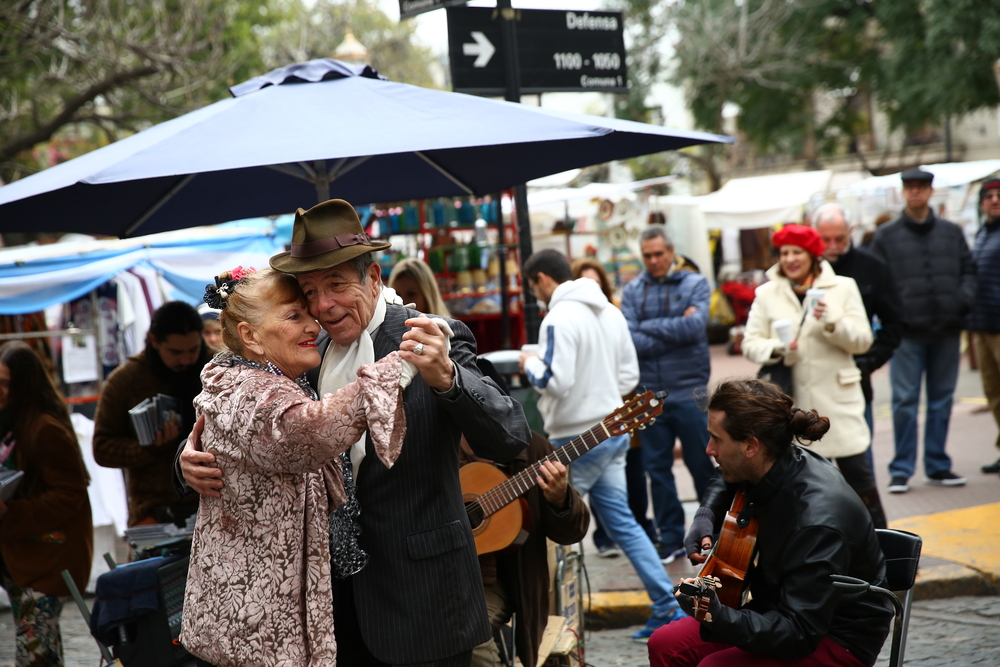
This time I take a hotel in the Palermo district for a couple of days acclimatisation before I start my travels in Patagonia. The streets may have changed but the atmosphere is unaltered. I dine on the pavement into the late hours and stroll through the city’s impressive parks to the Museum of Modern Art by day. In the evening I venture to the Plaza de Mayo where mothers in their eighties are still claiming justice for those that had disappeared in the country’s darkest times during the 1970s – unfortunately it is not only the good that hasn’t changed.
Puerto Madryn Patagonia Argentina
However I have not come to revisit familiar ground but to venture into something new. The following day I make my way to the bus station for the long trip to Puerto Madryn, 1,300 kilometres to the south in Patagonia. But before I visit the adopted land of my fathers I have one stop to make.
Entering the guest house, I dimly expect to encounter some knife-wielding Psycho-inspired host, who will ensure that my stay at Bates Motel lasts much longer than expected
The Valdes Peninsula lies a few kilometres to the north of Puerto Madryn. Home to a colony of seals, the peninsula also hosts whales that come here each year to give birth. In all my travels I have yet to see a whale. There are many companies that specialise in whale watching, but as the bus drops me at the small town of Puerto Piramides, I am informed that the seas are too rough and no boats are currently sailing. I have all day to wait, so decide to walk along the vast beaches where I soon become enraptured by the beauty of the cliffs, their faces ravaged by the Atlantic’s ceaseless progression, a home to many a migrating bird. By the time I return to the port I am quite resigned to my non-sail, only to hear that the waves have imperceptibly relented and the afternoon trips will sail.
I have always loved boats. Ever since I was a child, when I managed to sleep through the roughest storm on the Irish Sea, I have felt at home either on or in water. It is the former I wish to stay as our boat ploughs its way through the calming waters. Almost immediately a fearless mother baleen whale surfaces close to us. We are lucky as it is December and towards the end of the mating season. No doubt she is giving her offspring some last instructions before letting her beloved loose in the Atlantic – male whales are absent fathers. The sudden sighting of this most magnificent beast takes me by surprise and I soon settle back down for more, only to be disappointed. The good traveller requires patience, a quality I have always lacked. At some stage I give up on another sighting and resign myself to the futile bobbing of our boat as if I were in search of Godot rather than Moby Dick.
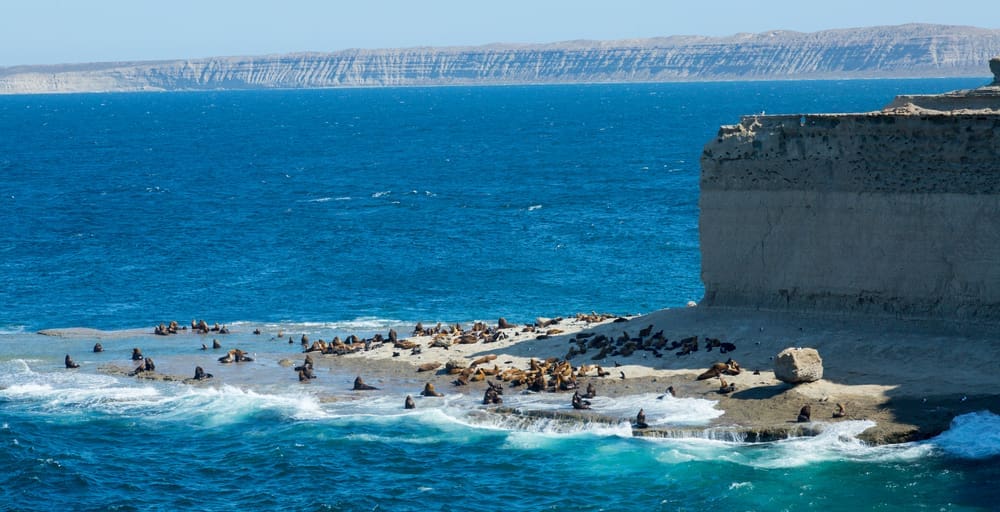
But it is for Wales rather than its homophonic mammal that I have travelled. The following day I take the short trip to Trelew which was at the heart of the Welsh settlement here in Patagonia – as well as being a watering hole for Butch Cassidy and the Sundance Kid in their pre-Bolivian days.
Trelew is the sort of town that you can cover in a couple of hours and still feel short changed. However, it does have one redeeming feature – the Hotel Touring Club. Forget the misleading name, this is no caravan park but a fine watering hole at the centre of everything that happens in town. It’s easy to imagine Butch and Sundance – who stayed here – settling down for a shot of bourbon and cold beer at the impressive bar, even though the current building, which replaced the burnt down original, post-dates the outlaws’ demise. Outside on the streets a small stage hosts the town youths’ enthusiastic efforts at heavy metal in some semi-organised festival, so I seek refuge inside as if I were on the run myself.
There is little point in staying in Trelew unless you are on the way to somewhere else. Photographs in the Touring Club’s bar indicate that legends of the Welsh national game have visited these parts on some tour. I distantly make out Mervyn Davies and Phil Bennett. Perhaps they too took the short bus trip to Gaiman, a town founded by David Roberts – fine Welsh name – in 1874.
At the turn of the last century the Welsh settlers in Patagonia built a now disused railway to link the tumbleweed town to Trelew. A small but strangely intriguing museum has been configured in the former station house to commemorate the event. But such endeavours do little to explain why they travelled across the tempestuous ocean to come here in the first place. Perhaps the answer lies in Capel Bethel, a Welsh chapel where they could exercise their religion freely. Or was it a communal spirit of adventure? Whatever the cause, fragments of the culture survive in its annual September youth Eisteddfod and afternoon English tea.
Inevitably there is the odd miscreant who believes the essence of being in nature is to have your photograph taken while standing on one leg and stretching your arms out as if an eagle in mid flight
I choose to believe they were drawn by the vast open spaces offered in Patagonia, as far removed from the verdant valleys of south Wales as imagination can take you. It is through these plain plains that I travel the following day and well into the night. The dust is unrelenting as we hug the thin road that cuts a swathe through the countryside towards the faraway Andes and into the most brilliant sunset. There is a tranquillity in the level terrain, and I feel at peace casting my eyes into the nothingness of the landscape. Time seems to stand still as my fellow passengers come and go, and I remain true to the bitter end.
Eventually, the bus stops at the small town of Los Antiguos on the Chilean border. Or rather it stops a few kilometres outside of town in the taxi-less bus station, as the clock ticks inevitably into the following day. I haven’t booked a room ahead.
Asking for information on potential accommodation, I am pointed in the opposite direction along the road we have just travelled – the final leg is to be taken on foot. At this time of night the sleepy town is peopled more by dogs than humans. The occasional barking serenade reminds me of the time I walked through the dusty streets of Indonesia in the early hours of the morning to watch a World Cup Final; a stick in hand to protect me from the marauding pack. It was goalless, settled by Baggio’s ponytail blazing over the bar in the shoot out. Then I had the foolhardiness of youth to blame, now I have no excuse. I am just about to give up and retrace my steps to the bus station when I see a light in the distance. Entering the guest house, I dimly expect to encounter some knife-wielding Psycho-inspired host, who will ensure that my stay at Bates Motel lasts much longer than expected. Instead I find a man clearly upset at being awoken at this time of the morning and a perfectly acceptable but charmless room.
I opted for Los Antiguos on the suggestion of my guide book, and am not disappointed. I spend the following day walking around the town’s lake and along a road that eventually snakes its way to Chile and its snowy mountains. I climb a small hill to appreciate the panorama. But my destination, at least for the time being, lies further south rather than to the west, and an overnight chariot awaits me.
Patagonia Argentina : El Chalten and Mount Fitzroy Trek
As we emerge from the bus shortly after sunrise, the heat of the coast is long-forgotten. The plains that have dominated my journey so far in Patagonia have now given way to the mountains for which this part of South America is renowned. El Chalten in Los Glaciares National Park is a trekkers paradise. There is a crisp nip in the air more reminiscent of Scotland than Wales. I stretch my tired body, to notice a young French woman disembark at the same time. In travel-honoured fashion we arrange to meet for a coffee once we have checked into our accommodation – hers a bunk in a dorm, mine a family apartment which was offered to me for the same rate as a single room in the adjoining hotel. All I have to do is find a family to join me.
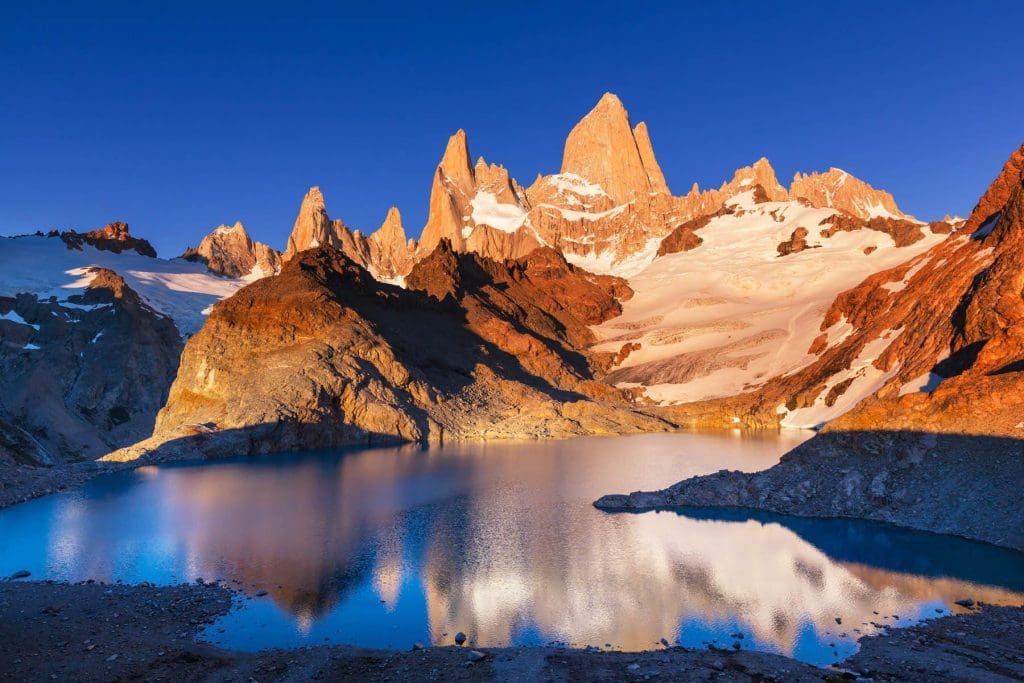
Over coffee we agree to tackle the Mount Fitzroy trek together. After all I’ve only just spent a sleepless night in a bus, what else would my body wish to do than walk eight hours across medium terrain?
Ten hours later as the cold beer slips effortlessly down my throat and my walking boots are peeled from my feet I feel I can relax at last. I have survived.
There are many words I could use to describe what transpired in the hours that intervened between the previous two paragraphs, but medium is not one of them. The trek starts with misleading simplicity. A gentle stroll through El Chalten is followed by a relatively steep but pleasant walk up a hill to a panorama and subsequently a lake where people are camping blissful in their ignorance of what lies ahead. Then follows an hour strolling through some beautiful terrain with mountains in the distance until we reach the sign. Just one more kilometre to the Laguna de Los Tres where we will be greeted with the most amazing views of Mount Fitzroy – the only snag is that it’s straight up.
As we slide and stagger our way up the unrelenting rocks, passing fellow stragglers and being passed in equal measure, all I can do to persuade myself to persevere up the never-ending path is to remind myself of the view promised at its summit.
I am not to be disappointed. Eventually, as we cross the final ridge, the snow unfolds before us and a small lake emerges beneath the impressive mountain. Despite the plenitude of equally intrepid – or is it deluded – hikers, the view is spectacular and our collective silence indicates the power that this place holds over us. Inevitably there is the odd miscreant who believes the essence of being in nature is to have your photograph taken while standing on one leg and stretching your arms out as if an eagle in mid flight, but even they can’t diminish the majesty of the setting. The only problem is the nagging feeling that only way down is back the way we have just come. Neither of my knees is looking forward to the descent. Fortunately my trekking companion stays with me all the way back to the village, with a bonhomie that makes my ordeal much more bearable.
Still, the beer at the end tastes good, as I swap anecdotes with another trekker whose legs too gave way on the descent.
Patagonia Argentina : El Calafate and Perito Moreno Glacier
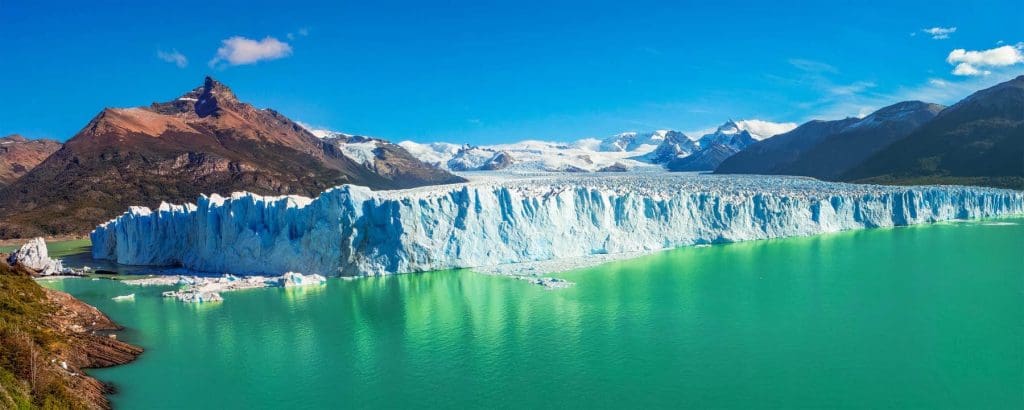
My final bus trip is the relatively short ride south to El Calafate. While El Chalten has managed to maintain its charm despite the take off of adventure tourism in the area, its more southerly neighbour has sold out hook, line and sinker. The streets are full of cafés and restaurants catering to the bus loads of tourists that are drawn to the Alpine climate. There is, however, one reason – and one alone – to come here, the Perito Moreno Glacier, the highlight of any journey in Patagonia.
Sometimes you arrive at a place full of expectation to leave disappointed. At other times enthusiasm tempered you are swept away in awe. Perito Moreno falls into the latter category.
Continue reading Mark’s adventures in South America with Patagonia Chile Around the Cape.
While most glaciers in the world are in retreat, Perito Moreno is most definitely on the front foot. Our boat takes us through the icy lake Argentino towards the glacier’s terminus where we can hear the ice cracking. An occasional loud explosion announces the crashing of a colossal shard of ice into the waters. Five kilometres wide and with an average height of 74 metres above the lake’s surface, with plenty more beneath, simple numbers fail to explain the effect that this natural wonder has upon the thousands of visitors who come here each year, many choosing to walk across its surface.
For me it is the colour. Previously I had considered ice to be white. But then I had yet to observe the clear blue that shines through when the sun catches its surface. Once our boat has docked back at its harbour we take to the trails around the glacier, which seems to change in hue with each shift of direction we make. When I booked my excursion I wondered how I would fill the over two hours between the conclusion of the boat trip and the return bus to El Calafate. By the end I am left wondering where all the time has disappeared. This is the highlight of my weeks in Patagonia. I feel that after all my travels I have truly found myself, only I wonder how many of my Welsh ancestors ventured this far.
A solitary flight later and I find myself in the Dublin Irish bar surrounded by young backpackers; some have come to the end of their lengthy journey across the continent, others are about to begin their voyage. Many are taking advantage of last-minute deals to visit the ultimate continent – Antarctica – from the many travel shops around Ushuaia.
My voyage will take me further south away from Patagonia Argentina into historically dangerous waters, to Patagonia Chile before I conclude my trip on the mystical Easter Island, home to the most amazing pre-historic statues.
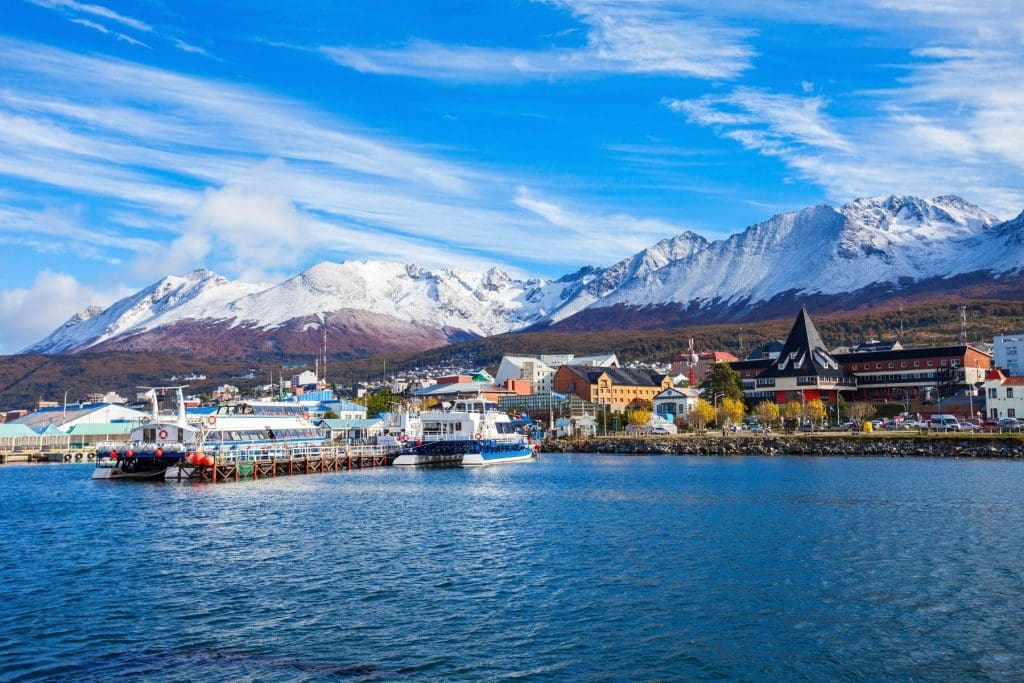
For information on Patagonia Travel
For further information on travelling through Patagonia Argentina, visit the official tourism information site.